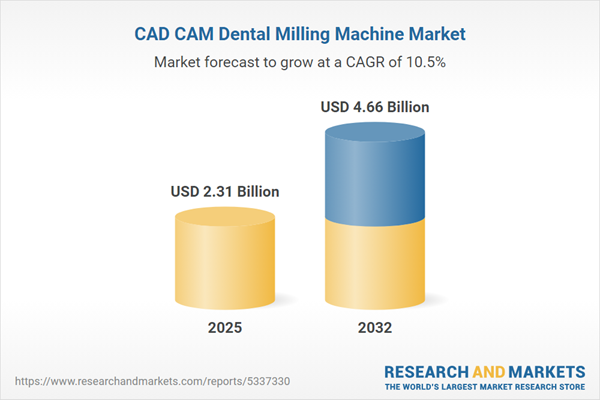Speak directly to the analyst to clarify any post sales queries you may have.
Senior dental sector executives are driving operational transformation through digitalization, with CAD CAM Dental Milling Machines at the forefront of this shift. As dental organizations focus on workflow innovation, technology adoption plays a pivotal role in building resilience and maintaining a competitive edge in an evolving marketplace.
Market Snapshot: CAD CAM Dental Milling Machine Market Size, Performance, and Outlook
The CAD CAM Dental Milling Machine Market is projected to expand from USD 2.09 billion in 2024 to USD 4.66 billion by 2032, indicating a compound annual growth rate of 10.51%. This market performance is propelled by rising demand for digital manufacturing and ongoing investment in enhanced clinical operations worldwide. Leadership teams are leveraging advanced manufacturing technologies to streamline workflows, accelerate case delivery, and improve outcomes for standard and complex dental restorative procedures. As organizations prioritize data integration and technology-driven processes, the sector is set to benefit from sustained growth and broader geographic reach.
Scope & Segmentation: Strategic Opportunities and Market Dynamics
- Material Types: Composite resins, hybrid ceramics, metals, PMMA, wax, and zirconia enable production of diverse dental restorations, accommodating routine clinical requirements as well as distinctive patient cases in both general and specialty practices.
- Axis Types: Two-axis, three-axis, four-axis, and five-axis milling models provide organizations with scalable options for automating workflows and matching equipment capacity to procedural complexity from basic to advanced prosthetic needs.
- End Users: Dental clinics, hospitals, academic institutions, and laboratories implement CAD CAM milling machines to standardize outputs, encourage interdisciplinary collaboration, and efficiently respond to varying operational and patient care goals.
- Applications: The equipment supports a broad spectrum of uses, including crowns, bridges, dentures, inlays, onlays, implant abutments, orthodontic appliances, and veneers, covering both restorative and diagnostic procedures across the sector.
- Operation Modes: Dry, wet, and hybrid milling modes provide flexibility, enabling organizations to adapt processes for different restoration types and material properties while supporting practice-based and centralized laboratory environments.
- Sales Channels: Direct procurement, distributor collaborations, and online sourcing channels help organizations optimize inventory control and align purchasing with regulatory, cost, and local market needs.
- Regional Coverage: Adoption trends are robust across North America, South America, Europe, Middle East, Africa, and Asia-Pacific, with leadership from markets such as the US, Germany, China, and Japan shaping global practices and supply chain standards.
- Leading Companies Covered: Dentsply Sirona Inc., Straumann Holding AG, Ivoclar Vivadent AG, Amann Girrbach AG, Zirkonzahn GmbH, Roland DG Corporation, vhf camfacture AG, DOF Inc., Shining 3D Tech Co. Ltd., and BEGO Bremer Goldschlägerei Wilh. Herbst GmbH & Co. KG are prominent organizations delivering advances and technical support for industry stakeholders.
Key Takeaways: Strategic Insights for Leadership
- Workflow automation and digital systems are enhancing collaboration between clinical and technical teams, establishing more consistent outcomes and higher reliability across restorative processes.
- Integrating advanced CAM software with multi-axis milling broadens the ability to personalize care and improves efficiency when addressing cases of increased procedural complexity.
- Innovations in ceramic and hybrid materials support adherence to international quality protocols, aiding organizations in remaining compliant amid changing regulatory demands.
- AI-driven maintenance predictions minimize operational disruptions by optimizing machine performance, ensuring steady production and efficiency.
- Regional, targeted sourcing strategies reinforce supply chain resilience, enabling organizations to adapt to distinct infrastructure capacities and regulatory requirements across different markets.
- Combining emerging CAM technology, advanced hardware, and cutting-edge materials provides scalable solutions designed to meet current and future shifts in dental care expectations.
Tariff Impact: Adapting to Shifting Cost Structures
Evolving tariff policies require North American dental institutions to reassess procurement strategies for CAD CAM Dental Milling Machines. By expanding supplier networks and focusing on regional sourcing, organizations are addressing regulatory exposure and promoting financial stability in a complex business environment.
Methodology & Data Sources
This analysis synthesizes findings from peer-reviewed academic research, industry documentation, and patent intelligence. It also integrates insights from expert interviews and sector surveys to offer a well-rounded understanding for robust strategic decision-making.
Why This Report Matters
- Detailed segmentation and actionable insights help executives reveal emerging digital manufacturing prospects and align responses with market drivers.
- Strategic analysis enables decision-makers to strengthen procurement, investment portfolios, and deployment of new technologies for greater resilience and operational efficiency.
- Structured frameworks support effective risk and technology assessments, helping organizations enhance both operational and capital resource utilization.
Conclusion
Digital advances in dental manufacturing are equipping senior leaders to modernize organizational workflows and proactively guide strategic growth, ensuring readiness for shifting market and patient needs.
Additional Product Information:
- Purchase of this report includes 1 year online access with quarterly updates.
- This report can be updated on request. Please contact our Customer Experience team using the Ask a Question widget on our website.
Table of Contents
3. Executive Summary
4. Market Overview
7. Cumulative Impact of Artificial Intelligence 2025
Companies Mentioned
The companies profiled in this CAD CAM Dental Milling Machine market report include:- Dentsply Sirona Inc.
- Straumann Holding AG
- Ivoclar Vivadent AG
- Amann Girrbach AG
- Zirkonzahn GmbH
- Roland DG Corporation
- vhf camfacture AG
- DOF, Inc.
- Shining 3D Tech Co., Ltd.
- BEGO Bremer Goldschlägerei Wilh. Herbst GmbH & Co. KG
Table Information
| Report Attribute | Details |
|---|---|
| No. of Pages | 198 |
| Published | November 2025 |
| Forecast Period | 2025 - 2032 |
| Estimated Market Value ( USD | $ 2.31 Billion |
| Forecasted Market Value ( USD | $ 4.66 Billion |
| Compound Annual Growth Rate | 10.5% |
| Regions Covered | Global |
| No. of Companies Mentioned | 11 |









